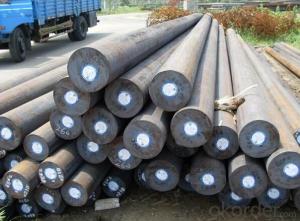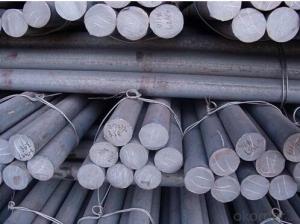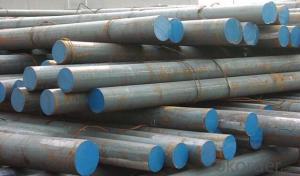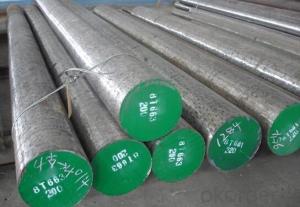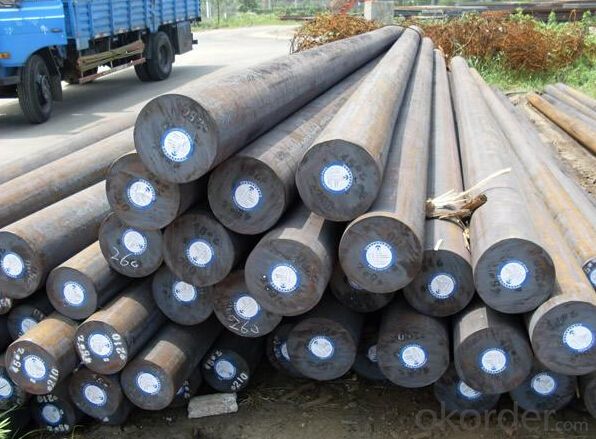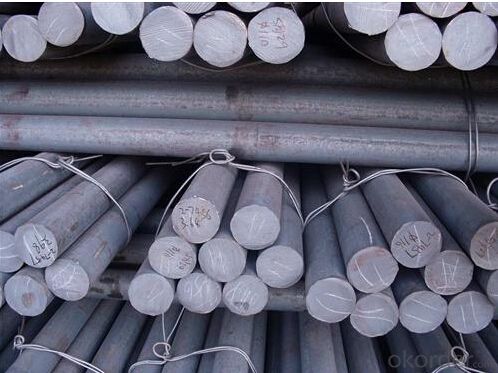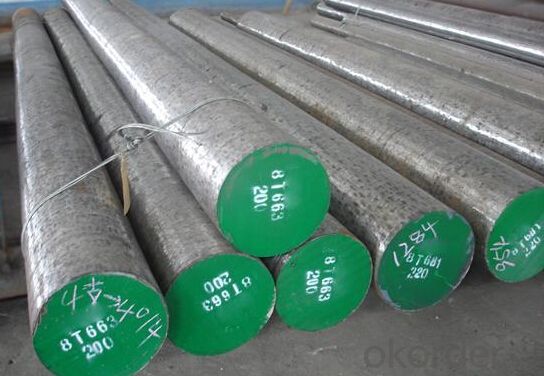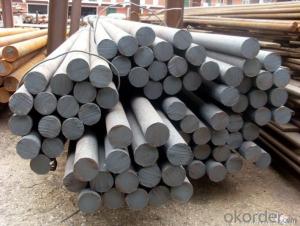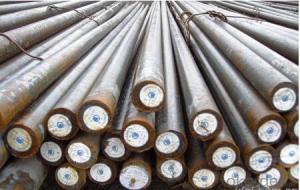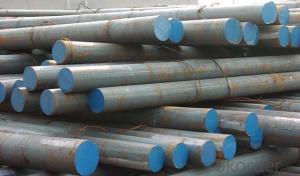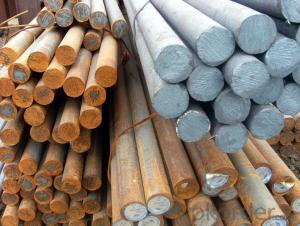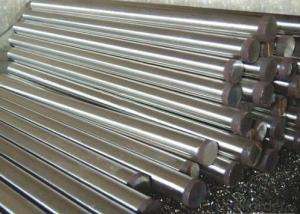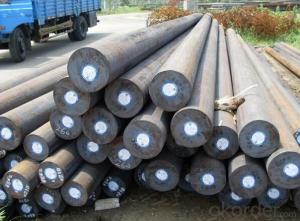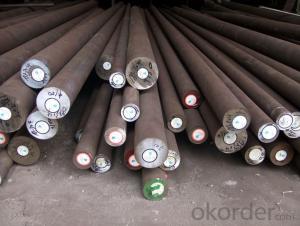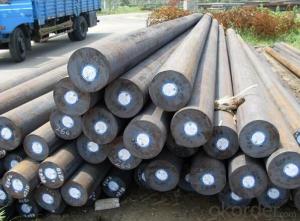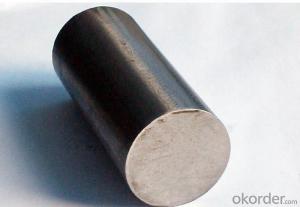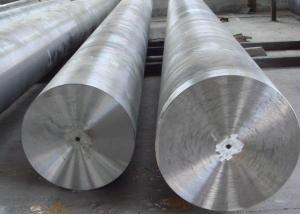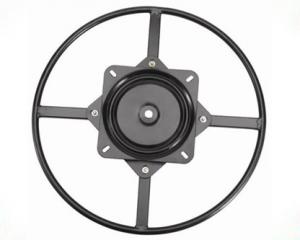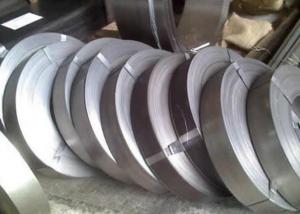Grade 4340 (ASTM A29) Alloy Special Steel Round Bar
- Loading Port:
- Shanghai
- Payment Terms:
- TT OR LC
- Min Order Qty:
- 30 m.t
- Supply Capability:
- 10000 m.t/month
OKorder Service Pledge
OKorder Financial Service
You Might Also Like
Specification
Specifications of Round Bar
1. Alloy steel round bar
2. Dia:16mm~250mm
3. Length: 6m, 9m, 12m or as customer’s request
4. Tolerance: Within ±5% for weight; ±2mm for diameter
5. Note: The price can be better is the quantity is good
Equivement Grade
DIN:34CRNIMO
SAE:4340
JIS:SNCM439(SNCM8)
BS:817M40
UNI:40NiCrMo7
Chemical Composition
C | Si | Mn | S | P | Cr | Ni | Cu | Mo |
0.37-0.44 | 0.17-0.37 | 0.50-0.80 | ≤0.025 | ≤0.025 | 0.60-0.90 | 1.25-1.65 | ≤0.025 | 0.15-0.25 |
Our Featured Products
Alloy steel: Combination of steel / Bearing steel// Spring steel/ Cr- mo steel
GB 20Cr/ 40Cr / 42CrMo / 35CrMo/ 20CrMn/GCr15/30CrMnTi…
ASTM 5120 /5140 / 4140/ 4135/ 5152/52100…
JIS SCr420H/ SCr440/ SCM3/ SUP9/SUJ2…
Carbon steel: Carbon tool steel /Carbon Structural Steel
GB 20/ 35 /45/…
ASTM 1020/ 1030/1045…
JIS S20C/ S30C / S45C…
Usage and Applications of Round Bar
1. Chinese standard steel bar is often used where large amounts of steel need to be formed, for example as structural steel.
2. And we can use this kind of product on the performance of the mechanical parts if the demand is not very high.
3. Steel round bar is used in construction and a large number of architectural and engineering structures.
Packaging & Delivery of Round Bar
Packaging Detail: All goods are packed in bundle with steel strips and shipped by break bulk vessel or container (depend on target market and different ports)
Delivery Detail: 15~45 days
Trade terms: FOB, CFR, CIF
MOQ: 30 metric tons per specification; we can negotiate the quantity if the specification is normal or we have stock of one specification.
Weight: Theprice invoicing on theoretical weight basis or actual weight basis depends on customer’s request.
Shipment: The shipment of bulk break or container is depends on customer’s request and the situation of the port of destination.
Documents given: Full set of original clean on board bill of lading; Original signed commercial invoice; Original packing list; Policy of insurance; Certificate of origin and what the target market needs.
Production Flow of Round Bar
1. The common processes are preheated forging quenching, dual refinement solution process, cooling quenching and isothermal quenching. We use heat treatment for dual refinement solution process.
2. Material prepare (billet) — heat up — rough rolling — precision rolling — cooling — packing — storage and transportation
FAQ:
Q1: Why buy Materials & Equipment from OKorder.com?
A1: All products offered byOKorder.com are carefully selected from China's most reliable manufacturing enterprises. Through its ISO certifications, OKorder.com adheres to the highest standards and a commitment to supply chain safety and customer satisfaction.
Q2: How do we guarantee the quality of our products?
A2: We have established an advanced quality management system which conducts strict quality tests at every step, from raw materials to the final product. At the same time, we provide extensive follow-up service assurances as required.
Q3: How soon can we receive the product after purchase?
A3: Within three days of placing an order, we will begin production. The specific shipping date is dependent upon international and government factors, but is typically 7 to 10 workdays.
Q4: What makes stainless steel stainless?
A4: Stainless steel must contain at least 10.5 % chromium. It is this element that reacts with the oxygen in the air to form a complex chrome-oxide surface layer that is invisible but strong enough to prevent further oxygen from "staining" (rusting) the surface. Higher levels of chromium and the addition of other alloying elements such as nickel and molybdenum enhance this surface layer and improve the corrosion resistance of the stainless material.
Q5: Can stainless steel rust?
A5: Stainless does not "rust" as you think of regular steel rusting with a red oxide on the surface that flakes off. If you see red rust it is probably due to some iron particles that have contaminated the surface of the stainless steel and it is these iron particles that are rusting. Look at the source of the rusting and see if you can remove it from the surface.
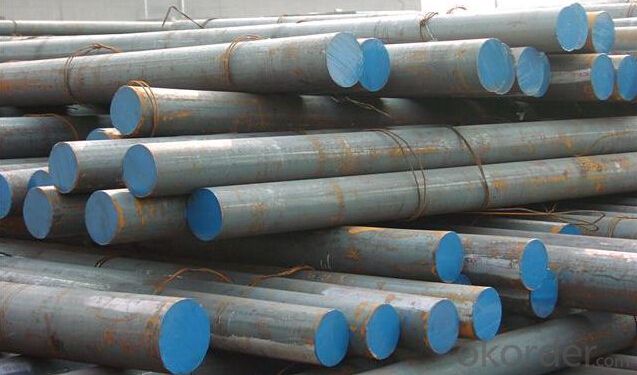
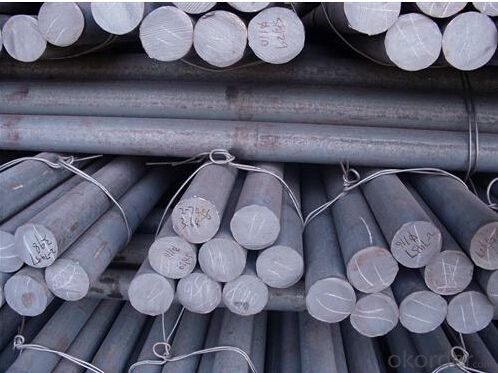
- Q: How does heat treatment affect the properties of special steel?
- Heat treatment can significantly impact the properties of special steel. By subjecting the steel to controlled heating and cooling processes, its mechanical properties can be modified. For instance, heat treatment can enhance the steel's hardness, strength, and toughness, making it more suitable for specific applications. Additionally, heat treatment can alter the steel's microstructure, such as grain size and distribution, thereby affecting its corrosion resistance and overall performance. Overall, heat treatment plays a crucial role in tailoring the properties of special steel to meet desired requirements.
- Q: What are the main applications of special steel in the pharmaceutical industry?
- Special steel is widely used in the pharmaceutical industry for various applications. One of the main applications is in the manufacturing of equipment and machinery used for drug production, such as mixing tanks, reactors, and centrifuges. Special steel is preferred in these applications due to its excellent corrosion resistance, high strength, and durability, ensuring the integrity of the pharmaceutical processes and preventing contamination. Additionally, special steel is also used for constructing cleanroom furniture and fixtures, which require high cleanliness standards to maintain the sterility of pharmaceutical environments. Overall, special steel plays a crucial role in ensuring the quality, safety, and efficiency of pharmaceutical manufacturing processes.
- Q: What are the properties of corrosion-resistant steel?
- Corrosion-resistant steel, also known as stainless steel, possesses several key properties. Firstly, it has a high resistance to corrosion, making it suitable for use in environments with exposure to moisture or corrosive substances. Secondly, it contains a minimum of 10.5% chromium, which forms a protective layer called chromium oxide on the surface, preventing further corrosion. Additionally, it has a strong resistance to staining, which makes it easy to clean and maintain. Moreover, corrosion-resistant steel exhibits excellent strength and durability, making it suitable for a wide range of applications in various industries.
- Q: How is wear-resistant tool steel used in the production of cutting tools?
- Wear-resistant tool steel is used in the production of cutting tools because of its high hardness, toughness, and resistance to wear. This type of steel can withstand the high pressures and temperatures generated during cutting processes, ensuring that the cutting tools maintain their sharpness and durability for extended periods. The wear-resistant tool steel is typically used to make the cutting edges or inserts of tools such as drills, milling cutters, saw blades, and lathe tools. It helps in improving the tool's performance, reducing tool wear, and increasing productivity in various manufacturing industries.
- Q: What are the properties of structural steel?
- Structural steel possesses several key properties that make it an ideal material for construction purposes. Firstly, it has a high strength-to-weight ratio, meaning it can withstand heavy loads and forces while remaining relatively lightweight. Secondly, it is highly durable and resistant to corrosion, making it suitable for both indoor and outdoor applications. Additionally, structural steel is highly versatile and can be easily fabricated into various shapes and sizes to meet specific design requirements. Lastly, it has excellent fire resistance properties, as it does not burn or contribute to the spread of flames, ensuring the safety of structures in case of fire incidents.
- Q: How does special steel contribute to the manufacturing of industrial machinery?
- Special steel contributes to the manufacturing of industrial machinery by providing enhanced strength, durability, and resistance to wear and corrosion. It allows for the production of components that can withstand high temperatures, heavy loads, and harsh operating conditions. This robust material ensures the reliability and longevity of industrial machinery, ultimately improving productivity and efficiency in various sectors such as mining, construction, and manufacturing.
- Q: Is special steel suitable for medical equipment manufacturing?
- Indeed, medical equipment manufacturing is well-suited for special steel. Often referred to as stainless steel, special steel is widely utilized in the creation of medical equipment due to its distinct characteristics. Its exceptional resistance to corrosion is of utmost importance in maintaining the hygiene and cleanliness standards mandated in medical settings. Moreover, special steel boasts remarkable strength and durability, guaranteeing that the equipment can endure frequent use and sterilization processes without compromising its quality. Furthermore, special steel can be effortlessly molded and shaped into intricate designs, making it an ideal choice for fabricating complex medical instruments and devices. In summary, the utilization of special steel in medical equipment manufacturing ensures the production of dependable and enduring products that meet the rigorous requirements of the healthcare industry.
- Q: Can special steel be used for making aerospace components?
- Yes, special steel can be used for making aerospace components. Special steel alloys, such as stainless steel or titanium alloys, possess high strength, excellent corrosion resistance, and good heat resistance, making them suitable for aerospace applications where lightweight, durability, and resistance to extreme conditions are essential.
- Q: How does special steel contribute to the mining machinery industry?
- Special steel contributes to the mining machinery industry by providing high-strength and durable materials for the construction of mining equipment. With its exceptional mechanical properties and resistance to wear, corrosion, and high temperatures, special steel enhances the performance and longevity of mining machinery, ensuring efficient and reliable operations in harsh mining environments.
- Q: What are the properties of titanium alloys?
- Titanium alloys have several notable properties. First, they are known for their exceptional strength-to-weight ratio, making them highly desirable in industries such as aerospace and automotive engineering. They also exhibit excellent corrosion resistance, even in harsh environments, which contributes to their durability and longevity. Additionally, titanium alloys possess a high melting point, allowing them to retain their structural integrity at elevated temperatures. These alloys are also biocompatible, making them suitable for medical applications such as orthopedic implants. Overall, titanium alloys combine strength, lightness, corrosion resistance, high melting point, and biocompatibility, making them versatile and valuable materials in various industries.
Send your message to us
Grade 4340 (ASTM A29) Alloy Special Steel Round Bar
- Loading Port:
- Shanghai
- Payment Terms:
- TT OR LC
- Min Order Qty:
- 30 m.t
- Supply Capability:
- 10000 m.t/month
OKorder Service Pledge
OKorder Financial Service
Similar products
Hot products
Hot Searches
Related keywords
